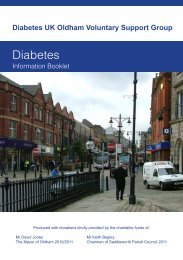61 CLAY LANE ROCHDALE OL11 5RH - Oldham Chronicle
61 CLAY LANE ROCHDALE OL11 5RH - Oldham Chronicle
61 CLAY LANE ROCHDALE OL11 5RH - Oldham Chronicle
You also want an ePaper? Increase the reach of your titles
YUMPU automatically turns print PDFs into web optimized ePapers that Google loves.
Water Quality failure report for United Utilities water quality supply zone Z232.The following samples failed during the calendar year ending 31/12/2007: -Parameter TestedNo. ofSamplesTakenNo. ofSamplesFailedColiform bacteria <strong>61</strong> 1United Utilities investigate all infringements of water quality standards thoroughly and take appropriatecorrective actions to resolve any problems. If there was any risk to public health from the quality of drinkingwater supplied, the Company would inform customers immediately and advise them not to drink the wateruntil the risk had been removed.Water samples are taken from customers’ taps, at addresses selected at random within a zone (zones can containapproximately 50,000 properties). The results of analysis given in the report relate to samples taken from a smallselection of addresses in the water supply zone in which the property is located, and not necessarily the propertyitself. There is only a small possibility that the results of samples reported were taken from the property in question.The sampling requirements and water quality standards are specified in Government legislation.Key facts on water qualityHere are some key facts on substances many customers are particularly concerned about. For more detailedinformation visit www.unitedutilities.com or telephone 0845 746 1324, minicom 0808 143 0295.LeadThere is virtually no lead in water as it leaves treatment works. Lead in drinking water originates from lead servicepipes and plumbing, mainly found in older houses. Occasionally a problem occurs due to the inappropriate use of leadbased solders on modern fittings. The extent of lead pick-up depends on the nature and extent of plumbing materialsand the water. Where United Utilities has identified a risk the water has been treated, as far as is practical, to minimisethe pick-up of lead in water. However, the best way of reducing lead in water is to replace lead pipes.HardnessWater hardness depends on the amount of calcium and magnesium in the water. Underground waters are usuallyharder than river or lake sources. Hard water makes it more difficult to get a lather when using soap and it can causedeposits in kettles. These deposits are not harmful to health. Most of our supplies are ‘soft’.AluminiumAluminium is present widely in the environment and exists naturally in lakes, rivers and reservoirs. It is also used atsome water treatment works to remove impurities and harmful micro organisms. Any aluminium is removed at a laterstage of the treatment process. The 200 µg/l standard for aluminium is not a health standard, but is based onconcentrations which affect the water’s appearance. Drinking water contains less than 5% of the daily dietary intake ofaluminium. For example, a cup of tea may contain 20 to 200 times more aluminium than the water it was made from.Coliform bacteriaThese bacteria are usually harmless in themselves, but if present show that if there is a possibility of contamination ofdrinking water, or disinfection is not working properly. Some of the bacteria we find are from dirty taps in houses, butin all cases where we find bacteria we respond urgently to make sure the water is safe.Iron and ManganeseNaturally occurring iron and manganese from upland reservoirs can be a problem in some places. Some iron alsocomes from the poor condition of older mains. Very high concentrations of iron and manganese can causediscolouration of washing. The presence of iron and manganese has no health significance.
















